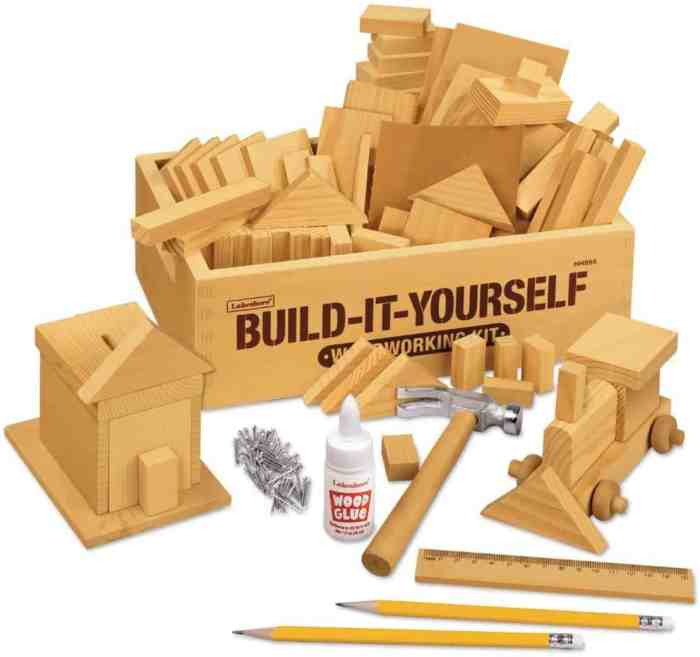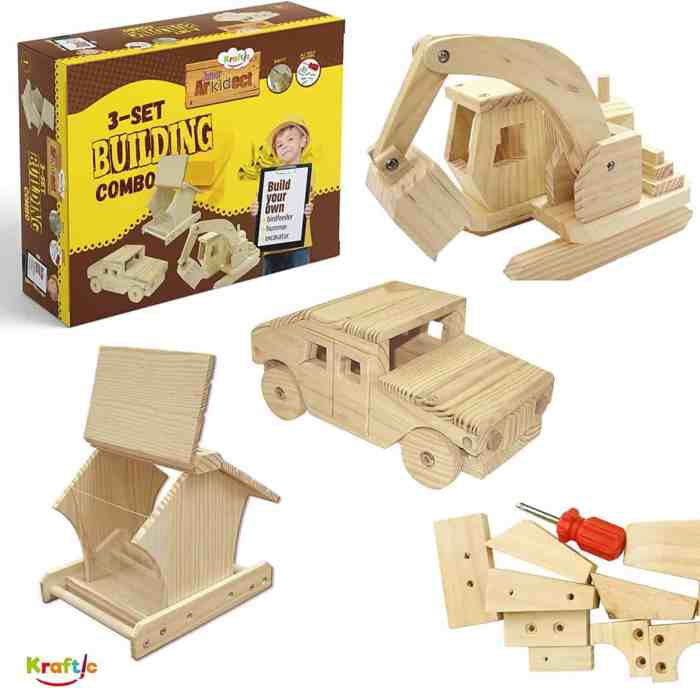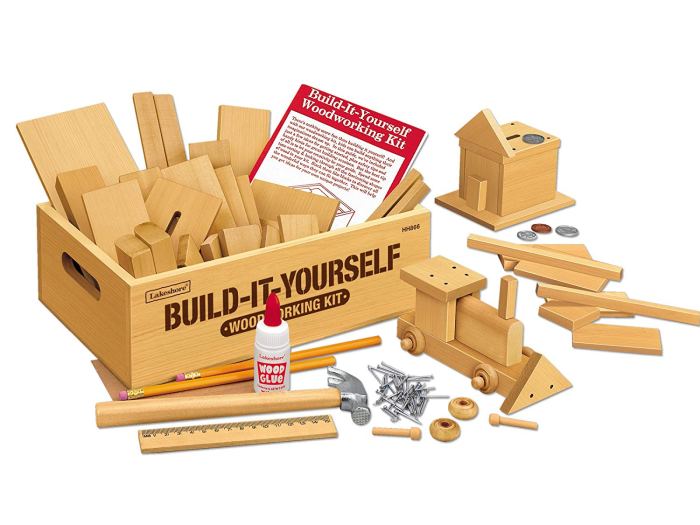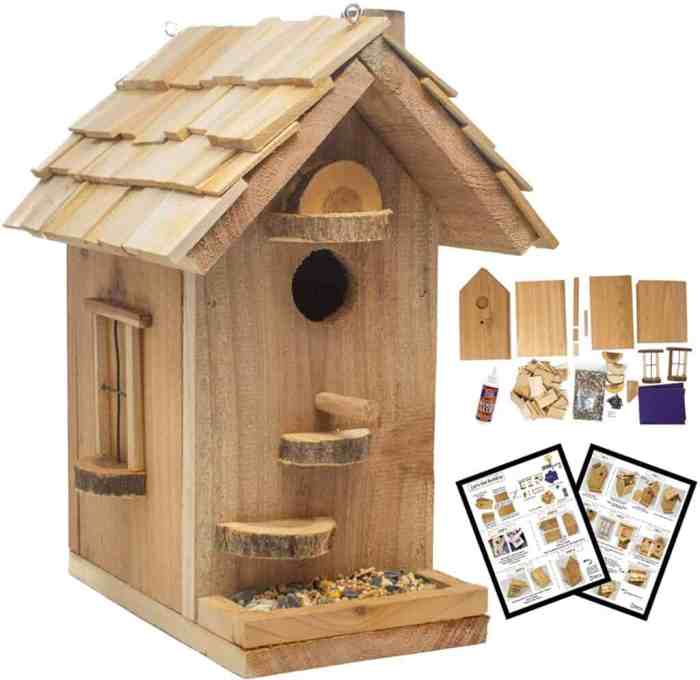Woodworking kits offer a fantastic way to delve into the world of woodworking, whether you’re a seasoned craftsman or a curious beginner. These kits provide everything you need to embark on a rewarding project, from carefully selected wood to detailed instructions, making the process accessible and enjoyable.
From building intricate furniture to crafting adorable toys, woodworking kits cater to diverse interests and skill levels. They provide a structured learning experience, guiding you through each step and helping you develop essential woodworking skills.
Introduction to Woodworking Kits
Woodworking kits have been around for decades, offering a fun and accessible way for people of all ages and skill levels to create their own wooden projects. From simple toys to intricate furniture, these kits provide a structured approach to woodworking, making it easier for beginners to learn the basics and for experienced crafters to explore new techniques.
The History and Evolution of Woodworking Kits
Woodworking kits have a long history, dating back to the early 20th century. Initially, they were primarily marketed towards children, providing a simple and safe way to introduce them to the craft. As the popularity of woodworking grew, kits became more sophisticated, catering to a wider range of ages and skill levels.
The early kits often included pre-cut pieces of wood, basic tools, and instructions for simple projects like birdhouses, toy cars, and small furniture pieces. Over time, kits evolved to include more complex designs, a wider variety of tools, and detailed instructions with illustrations and diagrams.
The advent of laser cutting technology in the late 20th century revolutionized woodworking kits. Precisely cut pieces of wood, intricate designs, and complex joinery became possible, allowing for the creation of highly detailed and intricate projects. Today, woodworking kits are available in a vast array of styles, materials, and complexities, offering something for everyone.
The Appeal of Woodworking Kits
Woodworking kits appeal to a wide range of individuals for several reasons:
- Accessibility: Woodworking kits offer a low-barrier entry point to the craft. They provide all the necessary materials and tools, eliminating the need for expensive equipment and specialized knowledge. This makes woodworking accessible to beginners who might be intimidated by the traditional approach.
- Structured Learning: Kits offer a structured learning experience, guiding users through each step of the process with detailed instructions and diagrams. This allows beginners to learn basic woodworking techniques and build confidence in their abilities.
- Sense of Accomplishment: Completing a woodworking project from a kit provides a sense of accomplishment and pride. It allows individuals to create something tangible and functional with their own hands, fostering a sense of creativity and self-reliance.
- Stress Relief: Woodworking can be a relaxing and therapeutic activity. The process of working with wood and creating something beautiful can be a great way to de-stress and unwind.
- Variety of Projects: Woodworking kits offer a wide variety of projects to choose from, catering to different interests and skill levels. From simple toys to intricate furniture, there is a kit available for everyone.
Types of Woodworking Kits
Woodworking kits are available in a wide variety of categories, each offering a unique set of challenges and rewards. Some popular types include:
- Furniture Kits: These kits allow you to build your own furniture, from simple chairs and tables to more complex pieces like cabinets and desks. Furniture kits often include pre-cut pieces of wood, detailed instructions, and necessary hardware.
- Toy Kits: These kits are perfect for children and adults who enjoy creating wooden toys. They offer a wide range of projects, from classic wooden trains and cars to more elaborate playsets. Toy kits often feature simple designs and easy-to-follow instructions, making them ideal for beginners.
- Decorative Kits: These kits allow you to create beautiful and functional decorative items for your home. Examples include wall clocks, picture frames, decorative boxes, and wooden signs. Decorative kits often feature intricate designs and require more precision and skill.
- Model Kits: These kits allow you to build scale models of various objects, such as ships, airplanes, cars, and buildings. Model kits typically require more advanced woodworking skills and often include a variety of materials, including wood, plastic, and metal.
Benefits of Using Woodworking Kits

Woodworking kits offer a fantastic way to dive into the world of woodworking, even if you’re a complete beginner. They provide a structured and guided approach to learning, making the process more accessible and enjoyable.
Time and Effort Savings
Woodworking kits eliminate the need to spend countless hours searching for materials, planning projects, and figuring out intricate cuts and joins. They come with pre-cut pieces, detailed instructions, and often, the necessary hardware. This streamlined approach allows you to focus on the fun part – assembling and finishing your project.
Structured Learning
Woodworking kits are designed to guide you through each step of the process, ensuring you learn the fundamentals of woodworking in a logical and sequential manner. The instructions are often detailed and easy to follow, making it easier to grasp essential techniques.
Sense of Accomplishment
Completing a woodworking project, especially your first one, can be incredibly rewarding. Woodworking kits provide a sense of accomplishment that comes from seeing your hard work transformed into a tangible piece. It’s a fantastic way to boost your confidence and encourage you to tackle more complex projects in the future.
Choosing the Right Woodworking Kit

Selecting the perfect woodworking kit is essential for a successful and enjoyable project. It involves considering your skill level, the desired outcome, and the kit’s features.
Types of Woodworking Kits
Choosing the right kit depends on your experience and project goals. Here’s a table comparing different types of kits based on skill level, project complexity, and price range:
| Kit Type | Skill Level | Project Complexity | Price Range |
|---|---|---|---|
| Beginner Kits | Novice | Simple projects like birdhouses or small shelves | $20 – $100 |
| Intermediate Kits | Some experience | More complex projects like chairs or tables | $50 – $200 |
| Advanced Kits | Experienced | Detailed and intricate projects like furniture or cabinets | $100+ |
Factors to Consider When Choosing a Kit
Beyond skill level, several factors contribute to choosing the right kit:
- Material Quality: Look for kits using high-quality wood, like hardwoods like maple or cherry, for durability and aesthetic appeal. Avoid kits using softwoods like pine, which can be prone to warping and damage.
- Tool Requirements: Some kits come with basic tools, while others require you to have your own. Consider your existing tools and whether you need to purchase additional ones.
- Desired Outcome: Determine the project’s complexity and size. Choose a kit that aligns with your desired outcome and skill level. Avoid kits that are too challenging or too simple for your current abilities.
Recommendations for Different Skill Levels
Here are recommendations based on experience:
- Beginners: Start with simple projects like birdhouses or small shelves. Choose kits with clear instructions and basic tools. Consider kits made of softwoods for easier working.
- Intermediate: Explore more complex projects like chairs or tables. Look for kits using hardwoods and offering detailed instructions. Consider kits that require some specialized tools, but not too many.
- Advanced: Tackle intricate projects like furniture or cabinets. Choose kits using high-quality hardwoods and offering detailed instructions. Expect to use a wide range of tools and techniques.
Essential Tools and Materials for Woodworking Kits
Woodworking kits are designed to be user-friendly, providing you with everything you need to complete a project. While the specific tools and materials included vary depending on the kit, some essential tools and materials are common across many kits. This section will guide you through these essentials, their uses, and how to choose the right ones for your project.
Common Woodworking Tools, Woodworking kits
Having the right tools can make your woodworking experience much smoother. Here’s a list of some common tools found in woodworking kits:
- Saw: A saw is used to cut wood to size. Woodworking kits often include a hand saw or a coping saw. Hand saws are used for straight cuts, while coping saws are designed for intricate curves.
- Hammer: A hammer is essential for driving nails and securing wood pieces together. It is important to choose a hammer with a comfortable grip and a head size suitable for the nails you will be using.
- Screwdriver: A screwdriver is used to drive screws, which are often used in woodworking kits for assembly and securing. It is important to have a screwdriver that fits the screw heads used in your kit.
- Measuring Tape: A measuring tape is crucial for accurate measurements and ensuring all your pieces fit together correctly. It is important to choose a measuring tape with clear markings and a sturdy construction.
- Pencil: A pencil is used to mark the wood before cutting or drilling. It is important to use a pencil that makes a clear mark and is easy to erase.
- Sandpaper: Sandpaper is used to smooth the surface of the wood and remove any imperfections. Different grits of sandpaper are used for different purposes. Fine-grit sandpaper is used for finishing, while coarse-grit sandpaper is used for rough sanding.
- Clamps: Clamps are used to hold pieces of wood together while they are being glued or assembled. They come in various sizes and shapes, and the type you need will depend on the specific project.
- Wood Glue: Wood glue is used to bond pieces of wood together. It is important to choose a wood glue that is suitable for the type of wood you are using and the project you are working on.
Types of Wood Used in Woodworking Kits
The type of wood used in a woodworking kit can greatly affect the final look and durability of your project. Here are some common types of wood used in woodworking kits:
- Pine: Pine is a softwood that is relatively inexpensive and easy to work with. It is often used in woodworking kits for beginner projects, such as birdhouses or small furniture.
- Oak: Oak is a hardwood that is known for its strength and durability. It is often used in woodworking kits for more challenging projects, such as furniture or decorative items.
- Maple: Maple is a hardwood that is known for its beautiful grain and durability. It is often used in woodworking kits for projects that require a high level of finish, such as furniture or cutting boards.
- Cherry: Cherry is a hardwood that is known for its rich color and beautiful grain. It is often used in woodworking kits for projects that require a high level of finish, such as furniture or decorative items.
- Walnut: Walnut is a hardwood that is known for its rich color and beautiful grain. It is often used in woodworking kits for projects that require a high level of finish, such as furniture or decorative items.
Safety Precautions and Techniques
Safety should always be a top priority when working with wood and tools. Here are some essential safety precautions and techniques to keep in mind:
- Always wear safety glasses: Woodworking can create flying debris, which can cause eye injuries. Always wear safety glasses to protect your eyes.
- Use proper tools and equipment: Make sure to use the right tools for the job and that they are in good working condition. Avoid using tools that are damaged or worn out.
- Keep your work area clean and organized: A cluttered workspace can be dangerous. Keep your work area clean and organized to prevent accidents.
- Use caution when using power tools: Power tools can be dangerous if not used properly. Always read the manufacturer’s instructions before using any power tool and wear appropriate safety gear.
- Be aware of your surroundings: Always be aware of your surroundings and the people around you when working with wood and tools. Avoid working in areas where there is a lot of foot traffic.
Steps Involved in Completing a Woodworking Kit Project

Woodworking kits are designed to make crafting projects more accessible, but it’s still essential to follow a structured approach to ensure a successful outcome. This section provides a step-by-step guide for completing a typical woodworking kit project.
Preparing for the Project
Before starting your project, it’s crucial to prepare your workspace and familiarize yourself with the instructions. This includes gathering all the necessary tools and materials, reviewing the instructions thoroughly, and ensuring you have a clean and well-lit workspace. A well-organized workspace minimizes distractions and helps you stay focused.
- Gather all necessary tools and materials: Carefully check the kit’s contents to ensure all components are present. Familiarize yourself with the names and functions of each tool.
- Review the instructions: Read through the instructions carefully before starting. Pay attention to the order of steps and any special techniques or precautions mentioned.
- Prepare your workspace: Choose a clean, well-lit, and well-ventilated area for your project. Make sure you have enough space to work comfortably.
Building the Project
This is where you put your woodworking skills to the test. It’s important to follow the instructions precisely and use the correct techniques for each step.
- Cut the wood: Use a saw to cut the wood pieces to the specified dimensions. Ensure the cuts are accurate and square. Use a measuring tape and a pencil to mark the cutting lines.
- Sand the wood: Smooth the edges and surfaces of the wood using sandpaper. This removes any rough edges and prepares the wood for finishing. Start with coarser grit sandpaper and progress to finer grits for a smooth finish.
- Assemble the pieces: Use glue, screws, or other fasteners to join the wood pieces together. Follow the instructions carefully to ensure the correct alignment and stability of the project.
- Finish the project: Apply a stain, paint, or varnish to the finished project. This enhances the appearance and protects the wood from damage. Allow the finish to dry completely before handling the project.
Troubleshooting Common Challenges
Even experienced woodworkers encounter challenges. Understanding common issues and how to resolve them can save time and frustration.
- Wood splitting: This can occur when drilling holes or driving screws. To prevent splitting, use a drill bit that’s slightly smaller than the screw diameter and pre-drill holes before driving the screws.
- Glue spills: If glue spills on the wood, clean it up immediately with a damp cloth. If the glue dries, it can be difficult to remove.
- Uneven cuts: Ensure the saw blade is sharp and the wood is securely clamped before cutting. Use a guide or a straight edge to ensure accurate cuts.
- Loose joints: Check the alignment and stability of the joints before gluing or fastening. If a joint is loose, use clamps to secure it in place.
Creative Applications and Customization of Woodworking Kits
Woodworking kits offer a fantastic foundation for crafting unique and personalized projects. Beyond the intended design, you can unleash your creativity and transform a basic kit into a truly unique piece.
Adding Decorative Elements
Adding decorative elements to your woodworking kit project can elevate its aesthetic appeal and reflect your personal style. Here are some ideas:
- Inlays: Use contrasting wood species or materials like mother-of-pearl to create intricate patterns or designs within the wood surface.
- Carving: Add depth and detail to your project by carving intricate patterns or designs into the wood. This technique can be used for both decorative and functional purposes.
- Painting and Staining: Enhance the natural beauty of the wood or create a vibrant color scheme with paints and stains. Consider using different finishes to achieve various effects, such as a distressed or antique look.
- Hardware: Upgrade the standard hardware with decorative hinges, handles, knobs, or drawer pulls. Choose materials like brass, bronze, or polished nickel to add a touch of elegance.
- Embellishments: Incorporate decorative elements like metal accents, glass tiles, or mosaic pieces to add a unique touch to your project.
Finishing Touches
Finishing touches are the final steps that bring your project to life and add a touch of professionalism.
- Sanding: Smooth out any rough edges and imperfections with sandpaper, gradually progressing through different grits to achieve a fine finish.
- Polishing: Use a polishing compound to enhance the shine and luster of the wood surface, especially on projects with a natural wood finish.
- Sealing: Protect your project from moisture and wear with a sealant, such as polyurethane or varnish. This step helps preserve the beauty of your woodworking project for years to come.
Creating Original Designs
While woodworking kits provide a solid starting point, you can easily adapt and customize them to create your own unique designs.
- Modify Dimensions: Adjust the size or proportions of the project to fit your needs or desired aesthetic. You can shorten, lengthen, widen, or narrow components to create a different look and feel.
- Combine Kits: Integrate elements from different kits to create a more elaborate and personalized project. This allows you to mix and match styles and functionalities.
- Add Functional Features: Incorporate additional features like shelves, drawers, or compartments to enhance the functionality of your project. For example, you could add a small drawer to a bedside table kit or create a storage compartment in a bookshelf kit.
- Explore Different Wood Species: Instead of using the wood specified in the kit, experiment with different wood species to create a unique visual and textural appeal. This allows you to play with different colors, grains, and textures to personalize your project.
Resources and Inspiration for Woodworking Kits
Woodworking kits provide a fantastic starting point for beginners and experienced woodworkers alike. Finding the right resources and inspiration can make your woodworking journey even more enjoyable and rewarding. Here’s a guide to help you discover the wealth of information available to support your woodworking endeavors.
Reputable Online and Offline Resources for Finding Woodworking Kits and Supplies
These resources offer a wide range of woodworking kits, tools, and materials to suit various skill levels and project types.
- Online Retailers: Websites like Amazon, Rockler, Woodcraft, and LumberJocks offer a vast selection of woodworking kits and supplies. You can browse by project type, skill level, and budget. Many retailers also provide detailed product descriptions, customer reviews, and videos to help you make informed decisions.
- Local Hardware Stores: Home Depot, Lowe’s, and local hardware stores often carry basic woodworking kits and tools. These stores can be convenient for quick purchases and in-person assistance.
- Specialty Woodworking Stores: Dedicated woodworking stores, such as Woodcraft and Rockler, offer a more specialized selection of kits, tools, and materials. They often have knowledgeable staff who can provide guidance and recommendations.
Woodworking Communities, Forums, and Blogs for Inspiration and Support
These online communities provide a platform for sharing ideas, asking questions, and getting feedback from fellow woodworkers.
- Woodworking Forums: LumberJocks, WoodworkingTalk, and Reddit’s r/woodworking are popular online forums where woodworkers of all levels can connect, share projects, and seek advice.
- Woodworking Blogs: Blogs like The Wood Whisperer, Popular Woodworking, and Fine Woodworking offer articles, tutorials, and project plans. These blogs often feature inspiring woodworking projects and techniques.
- Social Media Groups: Facebook groups and Instagram accounts dedicated to woodworking provide a space for connecting with other woodworkers and sharing your projects.
Books, Magazines, and Online Tutorials Related to Woodworking Kits
These resources provide step-by-step instructions, project plans, and expert advice to enhance your woodworking skills.
- Books: “The Complete Illustrated Guide to Woodworking” by Glen D. Huey and “The Woodworker’s Bible” by Bob Lang offer comprehensive guides to woodworking techniques and projects.
- Magazines: “Fine Woodworking,” “Popular Woodworking,” and “Woodworking Magazine” feature articles, project plans, and reviews of woodworking tools and materials.
- Online Tutorials: YouTube channels like The Wood Whisperer, Paul Sellers, and Matthias Wandel offer a wealth of woodworking tutorials, covering everything from basic techniques to advanced projects.
Ultimate Conclusion: Woodworking Kits

With a little patience, creativity, and the right woodworking kit, you can bring your woodworking dreams to life. Whether you’re seeking a relaxing hobby, a challenging project, or a unique gift, woodworking kits offer a fulfilling and rewarding experience.
FAQ Summary
What is the best woodworking kit for beginners?
Look for kits with simple designs and clear instructions. Consider kits that use pre-cut wood and provide basic tools.
Are woodworking kits expensive?
Kits vary in price depending on the project complexity, materials used, and brand. You can find kits that fit various budgets.
Do I need any special tools for woodworking kits?
Most kits come with the essential tools you need, but you might require additional tools depending on the project.
Can I customize woodworking kits?
Absolutely! You can add personal touches, change the finish, or even modify the design to create unique projects.
Woodworking kits are a great way to get started with woodworking, offering everything you need to build a project from scratch. If you’re looking for a more challenging project, you might consider building your own woodworking cabinets. Cabinets require more precision and attention to detail, but they can also be incredibly rewarding to build.
Once you’ve mastered the basics with a kit, you’ll be ready to tackle more complex projects like cabinets.
